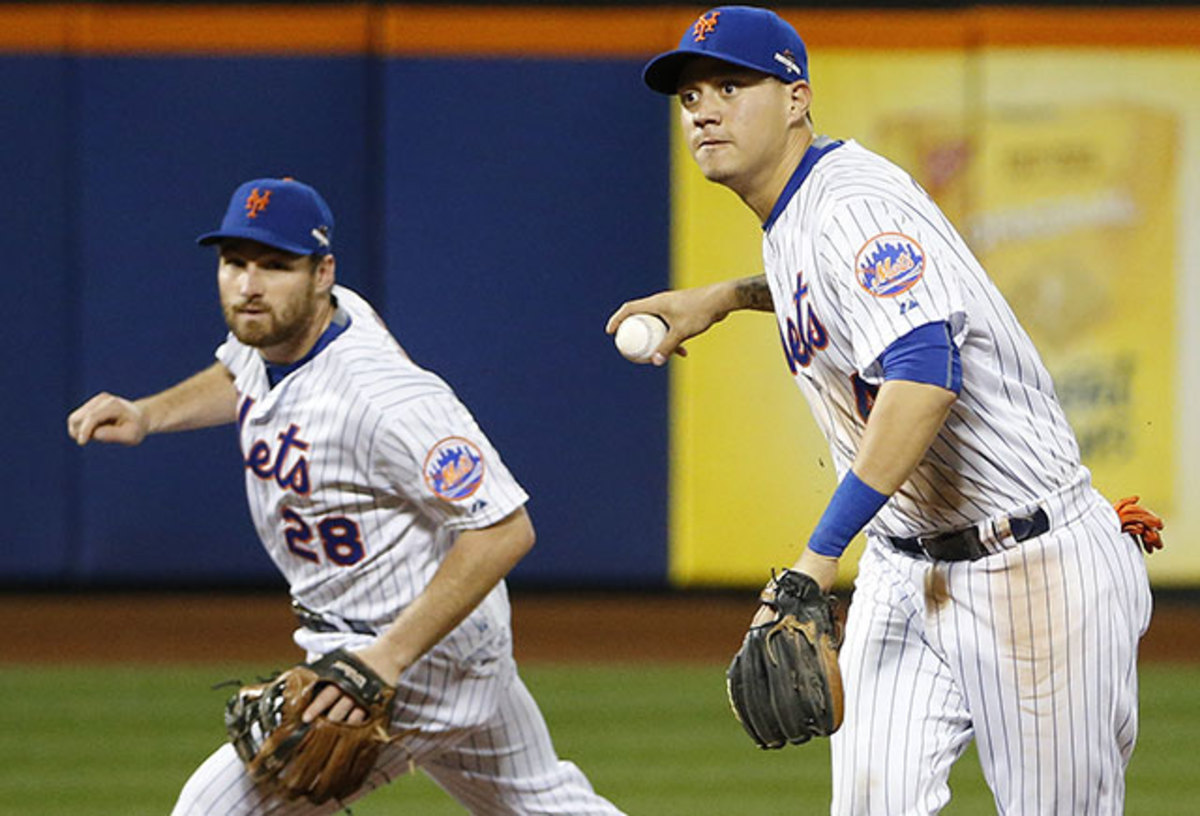Breaking down the six biggest keys to the Mets-Royals World Series

It took 55 years for the first all-expansion World Series to happen, so it is fitting that the headliners of the 111th Fall Classic are not the repeat American League champion Royals. The spotlight is instead on the new kids on the block: the four young arms of the Mets’ starting rotation. The story of this World Series is what becomes of Matt Harvey, Jacob deGrom, Noah Syndergaard and Steven Matz, the hardest-throwing rotation in baseball that seems bound either for historical greatness or a collapse at the finish line.
None of the Flushing Four are older than 27. All have exceeded the most innings they ever have thrown. Three had Tommy John surgery between the ages of 19 and 24 years old. The one who didn’t, the 23-year-old Syndergaard, is the youngest and the one who has been pushed the most (throwing 59 2/3 more innings than he did last year).
World Series Game 1 preview: Harvey, Mets take on Volquez, Royals
Dominant through the first two rounds of the postseason, the Mets’ starters are four wins away from joining the territory of all-time great young rotations that pitched their teams to a world championship. Among the title teams to get postseason wins from at least three pitchers ages 27 and younger are the 2010 Giants (Tim Lincecum, Matt Cain and Madison Bumgarner), the 1985 Royals (Bret Saberhagen, Danny Jackson and Mark Gubicza), the '72 Athletics (Catfish Hunter, Ken Holtzman and Blue Moon Odom) and New York's franchise forefathers, the '69 Mets (Tom Seaver, Jerry Koosman and Gary Gentry).
These Mets dropped just two games against the Dodgers and Cubs to reach the World Series. But such ease hardly came as a surprise: Their young arms were able to exploit those lineups that featured hitters with big swings and pull-hitting approaches. The ability to get strikeouts made it easier to escape trouble.
The Royals present a much more difficult challenge than did Los Angeles and Chicago. In fact, while the Dodgers (.259) and Cubs (.249) ranked 18th and 27th, respectively, in hitting with runners on this year, Kansas City (.286) ranked second, behind only the Blue Jays. The Royals hit an astounding .432 with runners on against Toronto in the ALCS. They will put the ball in play and force the Mets to defend the whole field, not just the pull field. Range is one of New York's weaknesses.
The Mets' path to a championship is to follow their young starters. Standing in New York's way is the deepest, most aggressive and most persistent lineup in baseball. Such a confrontation, in which the Mets get no free strikes and the Royals get no easy at-bats, is foremost among the key storylines heading into what looms as tension-packed baseball:

1. Power vs. feistiness
This confrontation is the entire World Series in a nutshell: Who wins the battle between the second-best strike-throwing rotation in history against the most difficult team to strike out in baseball?
Only the rotation of the 2011 Phillies (featuring Roy Halladay, Cliff Lee, Cole Hamels and Roy Oswalt) ever posted a better strikeout-to-walk rate than the 2015 Mets, whose rotation became even more formidable in the postseason by moving finesse pitchers Bartolo Colon and Jonathon Niese to the bullpen.
2015 World Series: Mets vs. Royals, position by position
The Royals, however, are the only team other than the non-contending 1971–74 Yankees to strike out the fewest times in the majors for four consecutive seasons. Putting the ball in play is Kansas City’s raison d’etre. The Royals don’t care about pitch counts; their goal is not to wear down the Mets' starters, but to beat them by putting the ball in play for hits early in the count.
The Mets are well aware of this strategy. Despite all the talk about New York’s velocity—the Mets have three of the 13 hardest-throwing starters in baseball—look for the team's starters to counter-attack by using their secondary pitches early in counts. The Mets will approach the Royals' hitters as if the count is 0–2 when they step into the box.
New York's staff averaged the fewest pitches per plate appearance in baseball (3.71). Kansas City's hitters saw the second-fewest pitchers per plate appearance in baseball (3.70). This is the most fascinating matchup of the series and the one most likely to decide it.
• MORE MLB: SI's experts make their World Series picks, predictions
2. Daniel Murphy’s dancing shoes
The six home runs Murphy has hit in six consecutive postseason games have come on four different types of pitches in five different counts in six different areas, including two that were out of the strike zone. In other words, the man is covering everything.
Where Daniel Murphy's postseason ranks among greatest of all time
Mets hitting coach Kevin Long gave Murphy a new timing mechanism this year to get his front foot down much sooner. He also moved Murphy closer to the plate, lowered his hands and put him in more of a crouched stance to “get into his legs.” The effect is that Murphy uses his legs more in his swing and can—as he did by taking Chicago reliever Fernando Rodney deep in NLCS Game 4—hit the outside pitch with power, which hitters call "bringing the outside inside."
The Royals see Murphy as too comfortable a hitter. Call his comfort level a Murphy bed: No hitter should be able to cover both sides of the plate as easily as he has. To make Murphy uncomfortable, Kansas City's pitchers have to pound him inside to either get him off the plate or let him hit pulled foul balls. (The second task is not so easily done: Murphy is such a strong bottom-hand hitter that he hits inside pitches without hook spin, which enables him to hit balls down the line that stay fair.) The task of getting Murphy out of his comfort zone begins in Game 1 with Edinson Volquez throwing his two-seam fastball at Murphy’s front hip and running it back on the inside edge of the plate.

3. The Mets’ poor interior design
The Royals have a huge edge on the Mets when it comes to athleticism. New York is particularly vulnerable in the middle infield: Shortstop Wilmer Flores, though he has good hands, and Murphy lack even average range. It’s very difficult for a team to win a world championship with poor interior defense, but if the Mets’ rotation keeps averaging 11.4 strikeouts per nine innings, New York just might be able to get away with it.
• MORE MLB: Full postseason schedule, start times, TV listings
4. Senior Circuit rules
The Mets have a big advantage for Games 3, 4 and 5, and it’s not just because they will be playing at home. The Royals lose their No. 5 hitter and leading RBI man, designated hitter Kendrys Morales, in the starting lineup in New York. Manager Ned Yost has proved he can’t wait to get to his deep bullpen, so he may use a pinch-hitter for his starting pitcher as soon as the second time that spot comes up. The problem there is that the middle three games of a seven-game series represent the only postseason window in which a team plays three straight games (or five straight if Game 1 is postponed by rain, which is a possibility). Going to your bullpen early and often under NL rules on that many consecutive days is fraught with trouble.
5. 'Pen-manship
The Mets held one of the greatest simulation games ever Monday, with hard-throwing rookies Syndergaard and Matz taking turns facing the team's hitters. It was like Baltimore's Jim Palmer and Dave McNally showing off before the 1966 World Series. But the faux start meant that Matz is not available out of the bullpen for Games 1 and 2 in advance of his Game 4 start.
World Series matchup features unfamiliar opponents in Mets, Royals
“We just couldn’t do that to him,” New York manager Terry Collins said. “He hasn’t done it, he has had some injuries this year, you never know about warming him up, and if he does get hurt in relief, then we have to go get someone to pitch Game 4. We decided to just leave him alone.”
The idea of Matz coming out of the 'pen was tempting because Collins does not have as many good bullpen options as does Yost. The Royals get the edge if they can have these games decided by the bullpen. Keep this number in mind: Over the past two seasons, including the postseason, Kansas City is 157–4 when it leads after seven innings.
6. Racing midnight
In 2013, the Cardinals worked with an idea of an innings limit for Michael Wacha, a 21-year-old rookie. But St. Louis and Wacha kept winning, so they kept giving him the ball. And Wacha looked terrific into October. He ran his innings odometer to 176 2/3 with four straight quality starts in the postseason.
Then he suddenly hit a wall. It happened to be an elimination game for the Cardinals: World Series Game 6. The Red Sox battered him for six runs in fewer than four innings. The next year, Wacha would throw only 109 innings due to a stress reaction in his shoulder, a likely result of mechanics and fatigue. Similar hard stops in the World Series hit Kevin Millwood (1999 Braves) and Justin Verlander (2006 Tigers) in their first time pitching a seventh month.
The Mets’ four young guns already have thrown more professional innings this year than ever before; as mentioned, Syndergaard is +59 2/3, while deGrom is +32 1/3, Harvey is +23 2/3 and Matz is +10 2/3. The greatest achievement by New York's organization this year—especially by Collins and pitching coach Dan Warthen—was to get four young starters to the last week of October not only healthy but also throwing the ball free and easy.
The Mets' NLCS sweep of the Cubs helped give their starters a needed breather. But the time to watch closely for fatigue will come if the series becomes a long one: Games 5, 6 and 7, when Harvey, deGrom and Syndergaard are scheduled to make their second start of the series.
